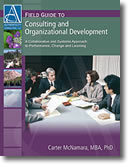How to Deal With Conflict
Sections of this Topic Include
- Clarifying Confusion About Conflict
- Types of Managerial Actions That Cause Workplace Conflicts
- Key Managerial Actions / Structures to Minimize Conflicts
- Ways People Deal With Conflict
- To Manage a Conflict with Another Person
- Additional Perspectives on Conflict Management
- General Resources About Conflict Management
Also consider
Related Library Topics
Note that many methods intended for addressing conflict between two people also might be considered as methods to address group conflict. Therefore, also see Conflict Management in Groups.
Learn More in the Library’s Blogs Related to Conflict Management
In addition to the articles on this current page, see the following blogs which have posts related to Conflict Management. Scan down the blog’s page to see various posts. Also see the section “Recent Blog Posts” in the sidebar of the blog or click on “next” near the bottom of a post in the blog.
- Library’s Coaching Blog
- Library’s Crisis Management Blog
- Library’s Leadership Blog
- Library’s Supervision Blog
Clarifying Confusion About Conflict
© Copyright Carter McNamara, MBA, PhD
Conflict occurs with two or more people who, despite their first attempts at agreement, do not yet have agreement on a course of action, usually because their values, perspectives and opinions are contradictory in nature. Conflict can occur:
- Within yourself when you are not living according to your values.
- When your values and perspectives are threatened.
- When there is discomfort from fear of the unknown or from lack of fulfillment.
Conflict is inevitable and often necessary when forming high-performing teams because they evolve through “form, storm, norm and perform” periods. Getting the most out of diversity often means addressing contradictory values, perspectives and opinions. Conflict is often needed. It:
- Helps to raise and address problems.
- Energizes work to be focused on the most important priorities.
- Helps people “be real” and motivates them to fully participate.
- Helps people learn how to recognize and benefit from their differences.
Conflict is not the same as discomfort. The conflict is not the problem – poor management of the conflict is the problem. Conflict is a problem when it:
- Hampers productivity.
- Lowers morale.
- Causes more and continued conflicts.
- Causes inappropriate behaviors.
Types of Managerial Actions That Cause Workplace Conflicts
© Copyright Carter McNamara, MBA, PhD
1. Poor communications
- Employees experience continual surprises, for example, they are not informed of major decisions that affect their workplaces and lives.
- Employees do not understand the reasons for the decisions – they are not involved in the decision-making.
- As a result, they trust the “rumor mill” more than their management.
2. The alignment or the amount of resources is insufficient. There is:
- Disagreement about “who does what.”
- Stress from working with inadequate resources.
3.“Personal chemistry,” including conflicting values or actions, for example:
- Strong interpersonal natures among workers do not seem to match.
- We do not like others because they seem too much like ourselves (we often do not like in others what we do not like in ourselves).
4. Leadership problems
For example, inconsistent, missing, too-strong or uninformed leadership (at any level in the organization), evidenced by:
- Avoiding conflict, “passing the buck” with little follow-through on decisions.
- Employees see the same continued issues in the workplace.
- Supervisors do not understand the jobs of their subordinates.
Key Managerial Actions / Structures to Minimize Conflicts
© Copyright Carter McNamara, MBA, PhD
1. Regularly review job descriptions. Get your employee’s input to them. Ensure:
- Job roles do not conflict.
- No tasks “fall in a crack.”
2. Intentionally build relationships with all subordinates.
- Meet at least once a month alone with them in office.
- Ask about accomplishments, challenges and issues.
3. Get regular, written status reports that describe:
- Accomplishments.
- Currents issues and needs from management.
- Plans for the upcoming period.
4. Conduct basic training about:
- Interpersonal communications.
- Conflict management.
- Delegation.
5. Develop procedures for routine tasks and include the employees’ input.
- Have employees write procedures when possible and appropriate.
- Get employees’ review of the procedures.
- Distribute the procedures.
- Train employees about the procedures.
6. Regularly hold management meetings with all employees.
For example, every month, communicate new initiatives and status of current products or services.
7. Consider an anonymous suggestion box in which employees can provide suggestions.
This can be powerful means to collect honest feedback, especially in very conflicted workplaces.
Ways People Deal With Conflict
© Copyright Carter McNamara, MBA, PhD
There is no one best way to deal with conflict. It depends on the current situation. Here are the major ways that people use to deal with conflict:
1. You can avoid it.
Pretend it is not there or ignore it. Use this approach only when it simply is not worth the effort to argue. Be aware that this approach tends to worsen the conflict over time.
2. You can accommodate it.
You can give in to others, sometimes to the extent that you compromise yourself. Use this approach very sparingly and infrequently, for example, in situations when you know that you will have another more useful approach in the very near future. Usually this approach tends to worsen the conflict over time, and causes conflicts within yourself.
3. You can compete with the others.
You can work to get your way, rather than clarifying and addressing the issue. Competitors love accommodators. Use this approach when you have a very strong conviction about your position.
4. Compromising.
You can engage in mutual give-and-take. This approach is used when the goal is to get past the issue and move on together.
5. Collaborating.
You can focus on working together. Use this approach when the goal is to meet as many current needs as possible by using mutual resources. This approach sometimes raises new mutual needs. Collaboration can also be used when the goal is to cultivate ownership and commitment.
To Manage a Conflict with Another Person
© Copyright Carter McNamara, MBA, PhD
1. Know what you do not like about yourself, early on in your career.
- We often do not like in others what we do not want to see in ourselves.
- Write down 5 traits that really bug you when see them in others.
- Be aware that these traits are your “hot buttons.”
2. Manage yourself. If you and/or another person are getting upset, then manage yourself to stay calm:
- Speak to the person as if the other person is not upset – this can be very effective!
- Avoid use of the word “you” – this avoids your appearing to be blaming the person.
- Nod your head to assure the person that you heard him/her.
- Maintain eye contact with the person.
3. Move the discussion to a private area, if possible.
- Many times, moving to a new environment invites both of you to see or feel differently.
4. Give the other person time to vent.
- Do not interrupt the person or judge what he/she is saying.
5. Verify that you are accurately hearing each other. When the other person is done speaking:
- Ask the person to let you rephrase (uninterrupted) what you are hearing to ensure you are hearing it correctly.
- To understand the person more, ask open-ended questions (avoid “why” questions – those questions often make people feel defensive).
6. Repeat the above step, for the other to verify that he/she is hearing you. Describe your perspective:
- Use “I”, not “you.”
- Talk in terms of the present as much as possible.
- Quickly mention your feelings.
7. Acknowledge where you disagree and where you agree.
- One of the most powerful means to resolve conflict is to mention where you both agree.
8. Discuss the matter on which you disagree, not the nature of the other person.
- Ask “What can we do fix the problem?” The person might begin to complain again.
- Then ask the same question. Focus on actions you both can do.
- Ask the other person if they will support the action(s).
- If the person will not, then ask for a “cooling off period”.
9. Thank the person for working with you.
- It takes patience for a person to engage in meaningful conversation during conflict. Acknowledge and thank the other person for his/her effort.
10. If the situation remains a conflict, then:
- Conclude if the other person’s behavior violates one of the personnel policies and procedures in the workplace and if it does, then follow the policy’s terms for addressing that violation.
- Otherwise, consider whether to agree to disagree.
- Consider seeking a third party to mediate.
Additional Perspectives on Conflict Management
Basic Advice (Suggestions, Steps and Tips)
- Basics of Conflict Management (conflict within yourself or with others)
- Conflict – An Essential Ingredient For Growth (basic styles to deal with conflict)
- Kare Anderson: Six Off-Beat Ways to Get Along Better
- The Right Way to Fight
- The Good Fight: How Conflict Can Help Your Idea
- How to Agreeably Disagree in 4 Steps
- 5 Ways to Foster Healthy Communication in Conflict Situations
- 7 Tips to Prepare for a Challenging Discussion
- Career Misfire: You’ve Said Things You Now Regret
- How Project Managers Can Manage Conflict
- Is Conflict at Work Good or Bad?
Also consider
- Building Trust
- Communications (Interpersonal)
- Communications (Organizational)
- Communications (Writing)
- Conflict (Interpersonal)
- Etiquette (Manners)
- Handling Difficult People
- Diversity and Inclusion
- Negotiating
- Office Politics
Towards Broader Views on Conflict in Organizations
- 13 Conflict Management Skills
- The Good Fight: How Conflict Can Help Your Idea
- How to Fix Misunderstandings at Work and in Life
Assessments
Miscellaneous Topics
- Can Conflict in Nonprofits Be Managed Successfully?
- Addressing Interpersonal Conflicts
- What Akaido Can Teach Us About Conflict
General Resources About Conflict Management
- Mediation Information and Resource Center
- How to Resolve Workplace Conflicts
- Conflict Management at the Office: How to Resolve Disputes
- Transformative Approaches to Conflict Resolution
- A Comparison of Conflict Style Inventories
For the Category of Interpersonal Skills:
To round out your knowledge of this Library topic, you may want to review some related topics, available from the link below. Each of the related topics includes free, online resources.
Also, scan the Recommended Books listed below. They have been selected for their relevance and highly practical nature.











